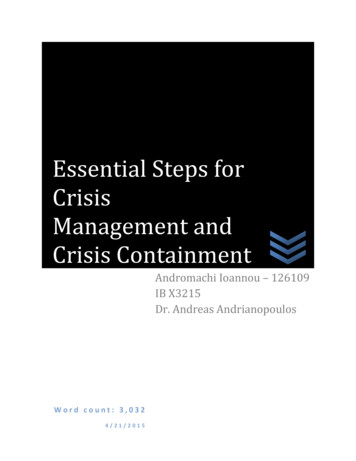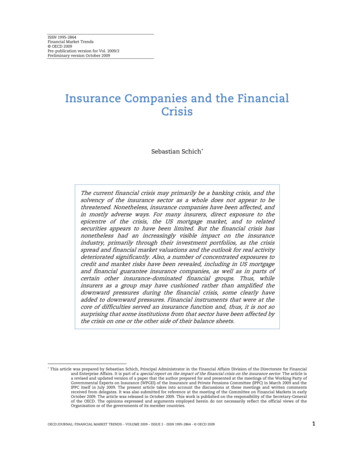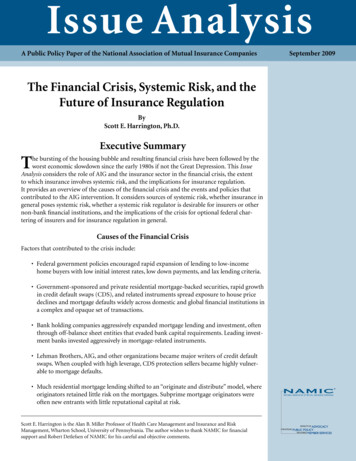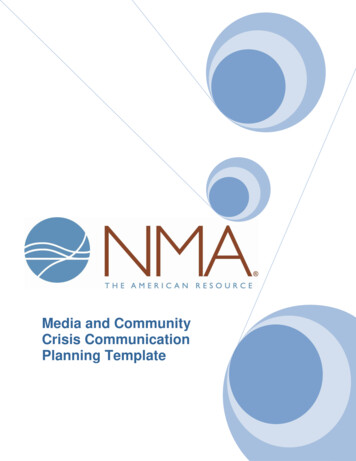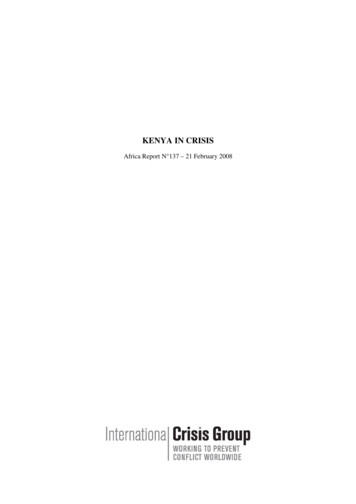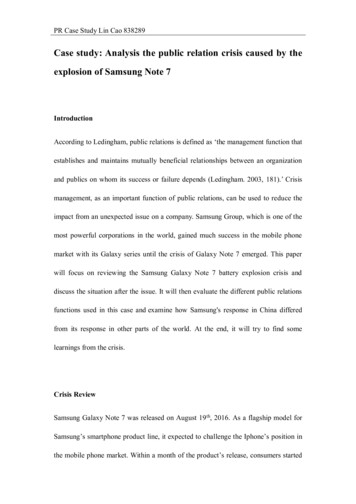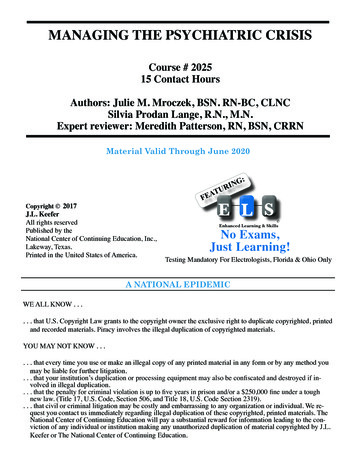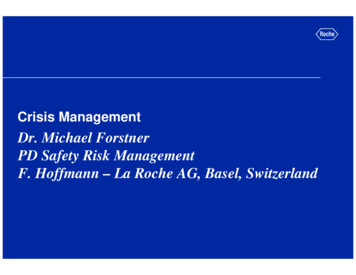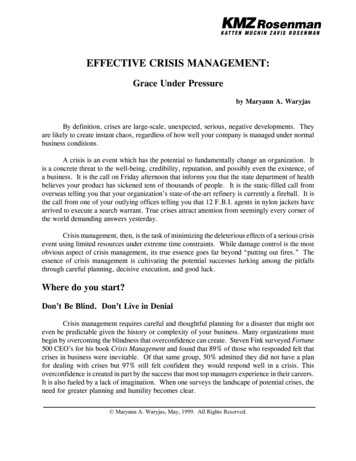
Transcription
1. The financial crisis of 2007/2008 and its impact on the UKand other economiesDo you still feel vague about the causes and the effects of the financial crisis of 2007/8?Are you preparing for a job interview in either the private or public sector?The events of 2007/8 have shaped both the current UK commercial and business scene andare now having a massive effect on the public sector. Similar impacts are being felt acrossEurope and the wider world. Knowing a bit more about what happened might give you moreconfidence going into the interview!This leaflet will give you a basic understanding of the causes of the financial crisis of2007/2008 and the impact which it had on the UK and other economies. Topics covered are: UK history which led up to the financial crisisThe effect on mortgagesThe banks’ reactionThe effect on the world marketThe effect on the UK marketThis leaflet concludes with self assessment questions.1
National and International IssuesThe financial crisis of 2007/2008 and its impact on the UK and othereconomiesWhat were the root causes of the crisis?The roots of the financial problems of thelast two/three years can probably betraced back to the deregulation offinancial markets in the US, the UK andthe Western European economies thatstarted in the 1970s and gathered pace inthe early 1980s. Deregulation swept awaymany of the governmental/regulatorycontrols and freed up organisations totrade across a wider range of activitiesand territories.Prior to 1970, banks, investment banks(known as merchant banks in the UK atthat time), building societies, stockbrokersand insurance companies operated verymuch in their own specialized tradingspheres. In some countries there werealso geographical constraints allied tothese sector trading constraints: in the US,institutions were often restricted totrading in certain states and in Europe, totrading in their own country.In the case of banks, there were tightcontrols on cash and capital ratios and,specifically, on what percentage ofdepositors’ funds could be lent out tocustomers.As these controls were relaxed andgovernments allowed these differentfinancial institutions to raise funds frommoney markets across the world and notsolely from depositors, financial servicesbusinesses were able to grow much morerapidly than had been previously possible.The effect was to liberalise credit (i.e.make it easier to borrow money) andeffectively to fuel a massive expansion ofpersonal debt, including mortgage debt.Why did problems initially come to light in the property sector?With almost unbroken rises in propertyvalues since deregulation the homemortgage markets and the ‘buy to let’markets became both very large and veryprofitable to banks worldwide.Thus some lenders, anxious to retain andexpand market share, offered loans thatwere often more than the face value ofthe underlying property and weresometimes as high as six or seven timesthe borrower’s income.This ratio compares to one that generallypertained in the tighter regulatory erawhere lenders would typically only lend acouple with two incomes an amount equalto twice the higher income plus the lowerincome.With high returns available on this type ofbusiness but, perhaps underestimatingthe higher element of risk involved (seeLeaflet 8 - Risk and Reward), someorganisations started to raise funds byselling off ‘bundles’ of their mortgage andloan deals to other lenders, who werelargely unaware of the original,underlying, transactions.This process was known as‘securitisation’.Page 2 of 5
National and International IssuesDuring early-mid 2007 the oil price beganto rise sharply, causing worldwide fears ofa trade recession. Rising unemploymenttriggered the beginning of a sharp rise inmortgage defaults, especially in the US,where many mortgages were secured onrun-down inner city properties and mobilehomes.Banks became increasingly worried aboutboth the value of their own mortgagebooks and particularly the value of themortgage-securitised investments theyhad bought from other institutions As aresult they became reluctant to lend toother banks in the short-term moneymarkets.These poorer quality mortgages werestyled, in the money markets, as ‘subprime’ mortgages (these are a type ofThis crisis of confidence led to majorliquidity problems for many banks andinsurance companies worldwide. Liquiditymortgage characterised as being taken on bya borrower with a low credit rating and oftensecured on a low value property. Lenders willcharge higher interest rates than forconventional mortgages as they seek tocompensate for carrying higher risk).means the ability of institutions, includingbanks, to meet their short term obligationsincluding repayment of short term loans.The oil price eventually peaked at 147per barrel in mid 2008.How did the crisis develop during 2008?The Bank of England had to providefinancial support to the Northern RockBuilding Society in the latter part of 2007,to prevent a run on the society’s cash bydepositors. It became necessary toformally nationalise Northern Rock inFebruary 2008 (i.e. the Governmentbecame its major shareholder, havingused taxpayers’ money to support it).major US mortgage finance operations,Fannie Mae and Freddie Mac, also had tobe rescued by the US FederalGovernment.Early in 2008 a major US investment bank,Bear Stearns, had to be rescued by J.P.Morgan with US Government support.The US Government declined to step in tosave Lehman Brothers, in order to showmarkets that they could not and wouldnot rescue every troubled financialinstitution.The crisis deepened in the summer of2008 and on the 7th September 2008, twoThen, on the 15th September 2008, thebiggest bankruptcy in the world to datetook place when Lehman Brothers Bankfailed with liabilities of US 600 billion.Page 3 of 5
National and International Issuesteetered on thethFigure 1 illus tra ting some of the events whi ch occurred when the US ma rkets opened on the 16 September 2008What was the effect on UK banks and other banks worldwide?In the UK, the Bradford and BingleyBuilding Society was effectivelynationalised in late 2008 and thenpartially sold to the Spanish GrupoSantander Bank. Also late in 2008 the UKGovernment partially nationalised thestruggling Royal Bank of Scotland Group,initially taking a 58% stake, but eventuallyby late 2009 raising this to some 84%.The UK Government also effectivelyforced the UK’s largest mortgage lender,Halifax Bank of Scotland (HBOS), whichwas in deep trouble, into the Lloyds TSBgroup and, in January 2009, took a 43.4%stake in the combined business. Other UKbanks, such as Barclays and HSBC,although not nationalised, were forced toraise capital by new share issues topreserve their capital ratios.Governments in Belgium, France,Germany, Ireland, Spain and Switzerlandtook similar actions to the UK to saveseveral of their now illiquid andundercapitalised banks. Iceland effectivelylost its previously heavily aggressivebanking sector. In the US, a total of 25banks failed in 2008.Despite a sharp cut in central bankinterest rates worldwide, interbanklending rates remained stubbornly high(showing the banks’ lack of confidence ineach others’ financial security), which inturn lead to a severe reduction in bothpersonal and corporate credit and a rapiddownturn in the housing and constructionmarkets.Page 4 of 5
National and International IssuesWhat were the effects in the UK?In the UK there was a large fall in retailsales, especially in the furnishing and DIYsectors. Businesses, already hit by fallingsales and profitability, faced increasingproblems in securing bank support forcontinued trading. Several well knownbrands either went out of business or hadto close a substantial number of outlets,for example MFI, Woolworths and Blacks.Unemployment rose, especially in the 1824 age groups.Falls in retail sales and rises inunemployment mean falling taxesrevenues for governments worldwide. TheUK was no exception. In the 4th quarter of2008 UK Gross Domestic Product (GDP)*fell by 1.5% and the country officiallyentered a period of recession.The recession continued through 2009.However signs of recovery becameapparent in the final quarter of the year,with GDP growth of just 0.3% althoughmany commentators still have concernsabout the robustness of the recovery.Perhaps one of the most reflective andincisive comments on the crisis period as awhole was that, at the time of theirrespective failures, the Northern Rock wasbuilding society trying to act like aninvestment bank and Lehman Brotherswas an investment bank trying to act likea building society!Self assessment questions.1. What was the trigger that effectively started the banking crisis in mid 2008?2. Can you describe the two main characteristics of a sub-prime mortgage?3. Which was the first UK financial institution to be hit by major liquidity problems in late2007 and which two British banks were forced to seek UK Government support?4. When did the UK officially come out of recession?*Gross Domestic Product: The total monetary value of all goods and services produced domesticallyby a country in each year. GDP growth is an indication of a country's economic health (See Leaflet 2,UK Government Debt and Borrowing).Page 5 of 5
(known as merchant banks in the UK at that time), building societies, stockbrokers . solely from depositors, financial services businesses were able to grow much more . banks, such as Barclays and
